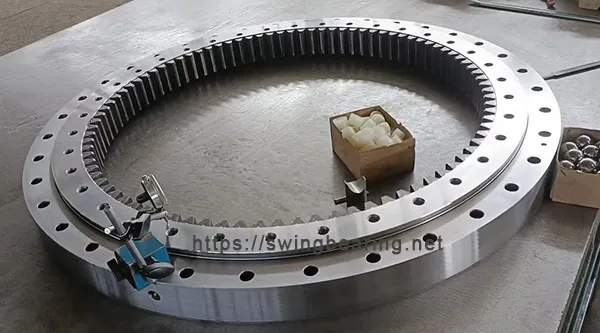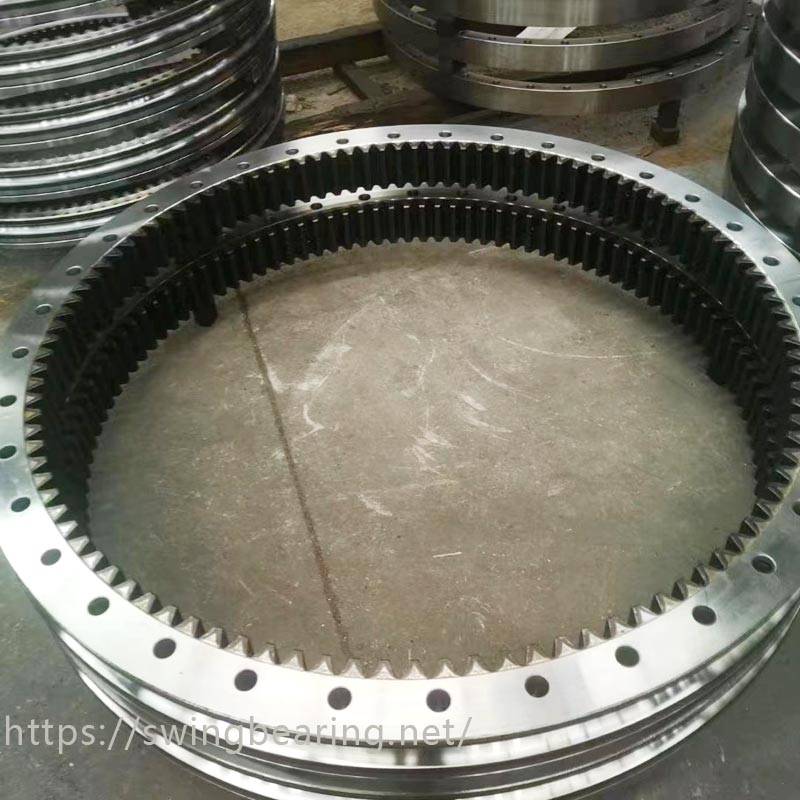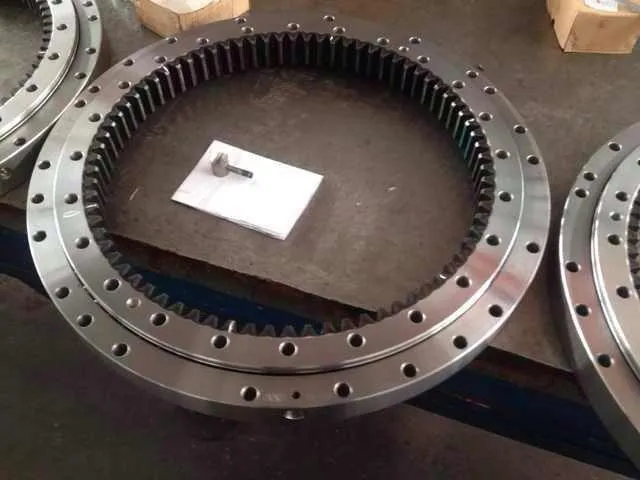
Slewing rings, crucial components in many heavy-duty machinery and equipment, come in various designs to meet specific operational needs. Two common types are single row ball slewing bearings and single row cross roller slewing bearings. Understanding the structural performance and characteristics of each type is vital for selecting the appropriate bearing for specific applications. This article delves into a detailed performance analysis of these slewing rings, highlighting their unique features, advantages, and limitations.
The contact points of single row ball slewing bearings are designed to be close to the theoretical position, ensuring optimal force distribution. This alignment with theoretical calculations ensures that the bearings can effectively handle the expected load without significant deviations.
Single row ball slewing bearings exhibit point contact, consistent with theoretical expectations. This point contact ensures that the stress is concentrated and evenly distributed across the contact points, contributing to the bearing’s efficient performance.
The rolling elements in single row ball slewing bearings experience pure rolling motion. This movement minimizes friction and wear, resulting in low rotary resistance torque and enhancing the bearing’s longevity and reliability.
Due to the pure rolling motion, single row ball slewing bearings have low rotary resistance torque. This characteristic makes them suitable for applications requiring smooth and efficient rotational movement.
The structure of single row ball slewing bearings is typically two-ring, which simplifies the machining process. However, creating the double-arc raceway requires specialized tools and precise processing techniques.

Single row ball slewing bearings exhibit good rigidity and low deformation, making them suitable for applications with slightly lower mounting bracket requirements. This rigidity ensures stable performance even under significant loads.
Steel balls, used as rolling elements in these bearings, are relatively inexpensive and easy to manufacture and match. This cost-effectiveness makes single row ball slewing bearings an attractive option for many applications.
The theoretical dynamic capacity of single row ball slewing bearings is generally smaller than that of cross roller slewing bearings. However, they can achieve the theoretical value and are widely accepted internationally for various applications.
In single row cross roller slewing bearings, the contact point between the rolling elements and the raceway is ideally positioned in the middle of the raceway. However, due to taper angle errors and assembly clearance, the actual contact point may deviate from this midpoint, potentially affecting the bearing’s performance.
The rolling elements in cross roller slewing bearings experience a combination of rolling and sliding motion, which increases the energy expenditure on wear. As a result, the rotary resistance torque is approximately twice that of single row ball bearings, making them less efficient in applications requiring low resistance torque.
The structure of cross roller slewing bearings is typically three-ring, requiring one additional blank and resulting in a larger processing volume. However, the right-angled raceway can be processed using standard lathes and general processing tools, simplifying the manufacturing process.

Cross roller slewing bearings exhibit poor rigidity and larger deformation compared to single row ball bearings. This characteristic necessitates high flatness and inclination requirements for the mounting bracket to ensure proper performance.
The rollers used in cross roller slewing bearings are more expensive and challenging to match compared to steel balls. This higher cost and complexity can impact the overall cost-effectiveness of the bearing.
Cross roller slewing bearings have a theoretically large dynamic capacity, approximately 50% greater than that of single row ball bearings. However, due to deviations in contact length and stress distribution from theoretical calculations, the actual dynamic capacity is only about one-third of that of single row ball bearings.
Both single row ball and single row cross roller slewing bearings offer unique advantages and limitations, making them suitable for different applications. Single row ball bearings are known for their low rotary resistance torque, good rigidity, and cost-effectiveness, making them ideal for applications requiring efficient and smooth rotation. On the other hand, cross roller slewing bearings, with their higher dynamic capacity and processing ease, are suitable for applications demanding higher load-bearing capacity despite their higher rotary resistance torque and cost.
Regular inspection and maintenance of slewing bearings are crucial to ensure their optimal performance and longevity. It is recommended to inspect the bearings every 200-500 operating hours, depending on the operating conditions. Lubrication should be checked and replenished as needed, and any signs of wear or damage should be addressed immediately to prevent further issues.
Signs of a failing slewing bearing include unusual noises during operation, increased vibration, difficulty in rotation, and visible wear or damage to the bearing components. Additionally, any leakage of lubricants or presence of contaminants in the lubricant can indicate potential bearing failure.
Replacing slewing bearings can be a complex task requiring specialized tools and knowledge. While it is possible to replace the bearings yourself, it is generally recommended to hire a professional with experience in handling such components. Professional installation ensures proper alignment, lubrication, and torque settings, reducing the risk of premature failure and ensuring optimal performance.
It is essential to use the lubricant recommended by the bearing manufacturer. The recommended lubricant is specifically formulated to meet the operating conditions and material compatibility of the bearing. Using the correct lubricant helps reduce friction, prevent wear, and extend the bearing’s lifespan. Always refer to the manufacturer’s guidelines or consult with a professional to determine the best lubricant for your specific bearing type.
To extend the life of slewing bearings, follow a regular maintenance schedule, including frequent inspections and lubrication. Ensure that the bearings are correctly installed and aligned, and avoid overloading the equipment. Protect the bearings from contaminants and environmental factors, and promptly address any signs of wear or damage. By adhering to these practices, you can significantly extend the lifespan of your slewing bearings and maintain optimal equipment performance.